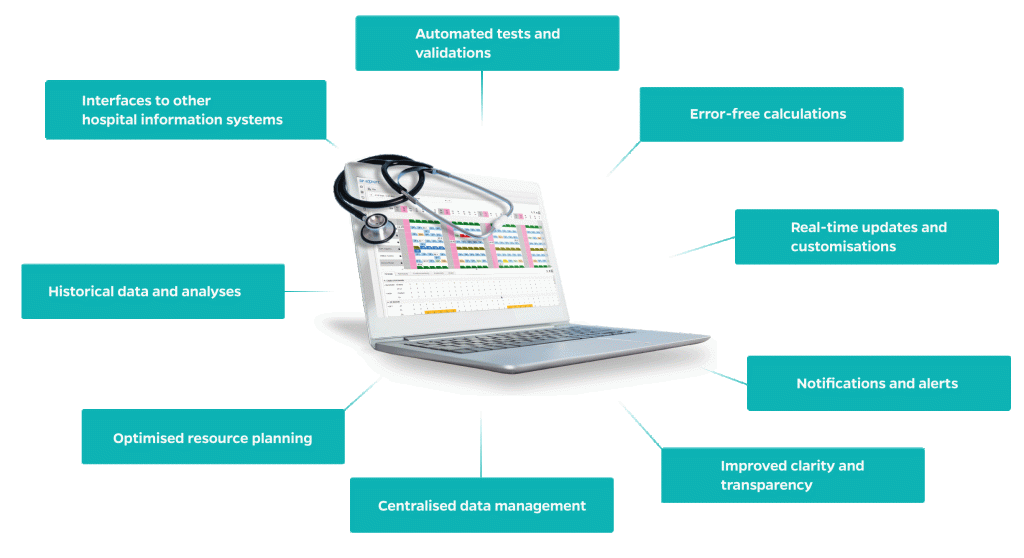Hospital Shift Schedule – The Importance of Digital Shift Scheduling and Its Success Factors!

The organisation of a hospital requires the coordination of a large number of activities and responsibilities, with shift scheduling playing a central role. Carefully thought-out shift scheduling is of great importance in order to ensure optimal patient care, promote employee satisfaction and at the same time ensure compliance with legal requirements.
Considering the ongoing shortage of skilled workers, the importance of efficient shift scheduling becomes increasingly evident. The lack of qualified personnel results in higher workloads and elevated stress levels among the existing workforce. Optimal shift scheduling helps to prevent excessive strain by ensuring fair distribution of shifts and early identification of staffing bottlenecks. This not only reduces pressure on employees but also enhances working conditions and promotes team satisfaction.
Innovative shift scheduling software supports hospital shift scheduling and helps to manage this complex task efficiently. By digital solutions, personnel resources can be optimally utilized, shifts fairly distributed, and short-term absences flexibly compensated. In this blog post, we explain how a digital solution can optimize shift planning in hospitals and why it is vital for modern healthcare organizations.
Content
↓ Hospital Shift Schedule – Definition and Relevant Influencing Factors in Its Creation
↓ Why the Hospital Shift Schedule Needs a Digital Update!
↓ Explanation of the 9 Key Advantages of a Digital Hospital Shift Schedule
↓ Workforce Management Software as a Digital Solution for an Optimal, Flexible, and Future-Proof of Hospital Shift Schedule
Hospital Shift Schedule – Definition and Relevant Influencing Factors in Its Creation
The hospital shift schedule determines which employees are active on the wards or in the various departments at any given time. This schedule concerns not only doctors but also nursing staff, therapists, technical personnel, and administrative employees. Despite the enormous importance of a well-functioning shift schedule, many hospitals face challenges, as they must consider numerous factors to ensure smooth and continuous patient care. In particular, the following points frequently lead to problems:
- High complexity: The multitude of factors that must be considered have challenging impacts on generating a shift schedule without appropriate tools. Particularly in large hospitals with many departments and various work time models, scheduling quickly becomes confusing.
- Shift work and overload: Hospitals operate around the clock, meaning that various shifts must be organized. However, shift work can strain employees if the distribution of working hours is not optimized. Too many night shifts or irregular working hours quickly lead to overload and dissatisfaction.
- Unpredictable changes: Illness, emergencies, or short-notice vacation requests require rapid adjustments to the shift schedule, especially in emergency departments or intensive care units. Vacation, sick times, and training days, as well as employee terminations, must also be considered to avoid staffing shortages. Manually altering and communicating these adjustments, however, is time-consuming and sensitive to errors.
- Legal and contractual requirements: Working time laws, collective agreements, break regulations, and legal requirements must be integrated into shift scheduling to ensure compliance.
- Increased patient load: During seasonal waves or unforeseen events, shift scheduling must be flexibly adjusted to provide sufficient staffing.
- Sensitivity to errors in manual planning: When shift schedules or short-term adjustments are generated manually, errors can quickly occur, leading to misunderstandings, non-compliance with scheduled working hours, and ultimately dissatisfaction. Such problems are time-consuming and can negatively impact the efficiency of the entire facility.
Please also read our following blog posts on legal aspects:
- „Implementing of PpUGV with Workforce Management“: https://plano-wfm.com/en/minimum-nursing-staff-limits-for-hospitals/
- „PPBV (PPR 2.0) in the Healthcare Sector – Efficiency and Transparency Through Digital WFM Software“: https://plano-wfm.com/en/ppbv-in-the-healthcare-sector-wfm-software/
Why the Hospital Shift Schedule Needs a Digital Update!
Shift scheduling in hospitals is a crucial process that affects both the workload of employees and the quality of patient care. While traditional, analog shift scheduling has been common for many years, more and more hospitals are switching to digital solutions to optimize their processes. The following comparison highlights the differences between manual or digital planning methods
Comparison of Manual vs. Digital Shift Scheduling

| Manual creation (paper/Excel), changes require manual intervention | Planning & Update | Automated creation and real-time updates; changes are made immediately without manual intervention |
| Only accessible on site or on a central computer accessible, manual notifications | Data access & Communication | Accessible at any time via web/app, immediate notification of changes, transparent |
| High error rate due to manual entries, no automatic legal control | Error Proneness & Working Time Law-Compliance | calculations and checking of working time laws, increased legal certainty |
| Becomes difficult to manage with growth, manual recording of absences, inflexible for spontaneous absences | Scalability & Recording of absences | Evolves with the hospital; automatically records absence reports, flexible for spontaneous absences |
| High operating costs and paper archiving with high risk of loss | Costs & Data security | One-time investment, secure archiving, low operating costs, high data security |
A Step Ahead: How Digital Shift Scheduling Surpasses Manual Scheduling.
Digital shift scheduling is increasingly establishing itself as a key technology for efficient organization in modern hospitals. In an environment characterized by high time pressure, demanding resource management, and strict legal requirements, it enables precise and error-free management of shift schedules. While manual scheduling reaches its limits with its many sources for errors and significant organizational effort, automated systems offer a far more accurate and flexible solution. These systems not only support error reduction, but also significantly contribute to optimizing workflows, increasing employee satisfaction, and improving the quality of patient care.
Explanation of the 9 Key Advantages of a Digital Hospital Shift Schedule

Automated checks and validations ensure that all working hours comply with legal requirements and collective agreements, while error-free calculations of working hours and overtime prevent potential calculation mistakes. Real-time updates provide the opportunity to immediately incorporate sick leaves or short-notice vacation requests, allowing the shift schedule to be adjusted promptly. Additionally, automatic notifications and alerts prevent shifts from being double-booked or left uncovered, ensuring that all working time guidelines are met. A digital shift schedule enhances clarity and transparency, allowing any errors to be quickly identified.
Centralized data management ensures consistent and uniform planning, with precise analysis of personnel requirements and employee availability optimizing resource planning. The consideration of employee preferences, such as desired shifts, is also easily possible, which strengthens employee retention and contributes to overall satisfaction. Furthermore, the evaluation of historical data enables continuous improvement in scheduling.
An essential component of modern shift scheduling in hospitals is an integrated time management. It seamlessly combines the recording of working hours and absences with the planning and organization of shifts. This not only enables precise scheduling in compliance with legal and contractual requirements, but also significantly reduces administrative effort. Working hours are recorded in real time and automatically matched with the shift schedule, enabling deviations or breaches of working time regulations to be detected accordingly.
Furthermore, integrated time management enables immediate interfaces to payroll and HR management systems. This ensures automated data flow without manual transfer errors and guarantees the correct calculation of overtime and surcharges. By combining all relevant time data in one system, high transparency is achieved for all involved, which fosters employee satisfaction and relieves scheduling managers.
Workforce Management Software as a Digital Solution for an Optimal, Flexible, and Future-Proof Hospital Shift Schedule
Shift scheduling in hospitals represents a complex challenge. Increasing demands in healthcare, legal requirements, and the need to enhance employee satisfaction demands a modern and efficient solution. plano solutions gmbh offers an innovative shift scheduling software that provides a digital solution which automates and optimizes the creation of shift schedules. This not only conserves resources but also significantly improves the planning processes.
Digital shift scheduling with plano WFM is characterized by a fully automated creation of shift schedules. Utilizing intelligent algorithms and powerful rule sets, the software considers all relevant legal requirements, operational demands, and individual employee preferences. This ensures reliable and compliant scheduling, significantly reduces manual effort and minimizes error rates.
A key advantage of the plano shift scheduling software is real-time adjustments. Unforeseen events such as sick leave, shift swap requests, or staff shortages can be dynamically considered. The shift schedules are updated immediately, ensuring rapid responsiveness and maximum operational security—crucial in hospitals and emergency situations.
plano WFM provides high flexibility for shift scheduling in hospitals. Through an intuitive web interface and the myplano shift scheduling app, both managers and employees have access to shift schedules at all times. This promotes transparency and improves internal communication. Changes to the shift schedule are communicated in real time, ensuring that employees are informed immediately.
Furthermore, employees can enter and manage their availabilities, preferences, and shift swaps directly via the platform. This contributes to employee satisfaction and increases the acceptance of the shift schedules, as individual preferences are considered. The opportunity for direct input strengthens employee retention and reduces turnover.
With its innovative pooling management, the plano WFM software offers flexible management of personnel resources. Particularly in hospitals with multiple departments and large teams, the pooling function ensures optimal staff distribution. The software allows staff to be allocated to different wards as needed. This prevents staffing shortages and maintains readiness for duty. Detailed information about plano Pooling can be found in our blog post.
The continuous plano shift scheduling optimization ensures that scheduling is continuously reviewed and updated. Through data-driven demand forecasting and analysis of shift coverage, overtime is minimized and idle times are avoided. This leads to more efficient use of personnel resources and lowers operating costs in the long term.
Conclusion: Digital Scheduling with plano as a Success Factor
Digital shift scheduling in hospitals provides a modern and powerful solution for optimizing staff planning with plano WFM. By combining automated schedule creation, pooling management, real-time adjustments, and high flexibility, the software perfectly meets the demands of the healthcare sector. Hospitals benefit from a significant increase in planning efficiency, improved employee satisfaction, and long-term cost reduction. With the plano modules, shift schedules can be designed transparently, flexibly, and efficiently – an indispensable prerequisite for successful hospital operations in the digital age.
Would you like to learn more about workforce planning in healthcare with plano?
You can find further information about our Workforce Management Software in the healthcare sector here:
→ Staffing Planning in the Healthcare Sector by plano
Archive
Employee Retention in Retail
We’re Here for You
